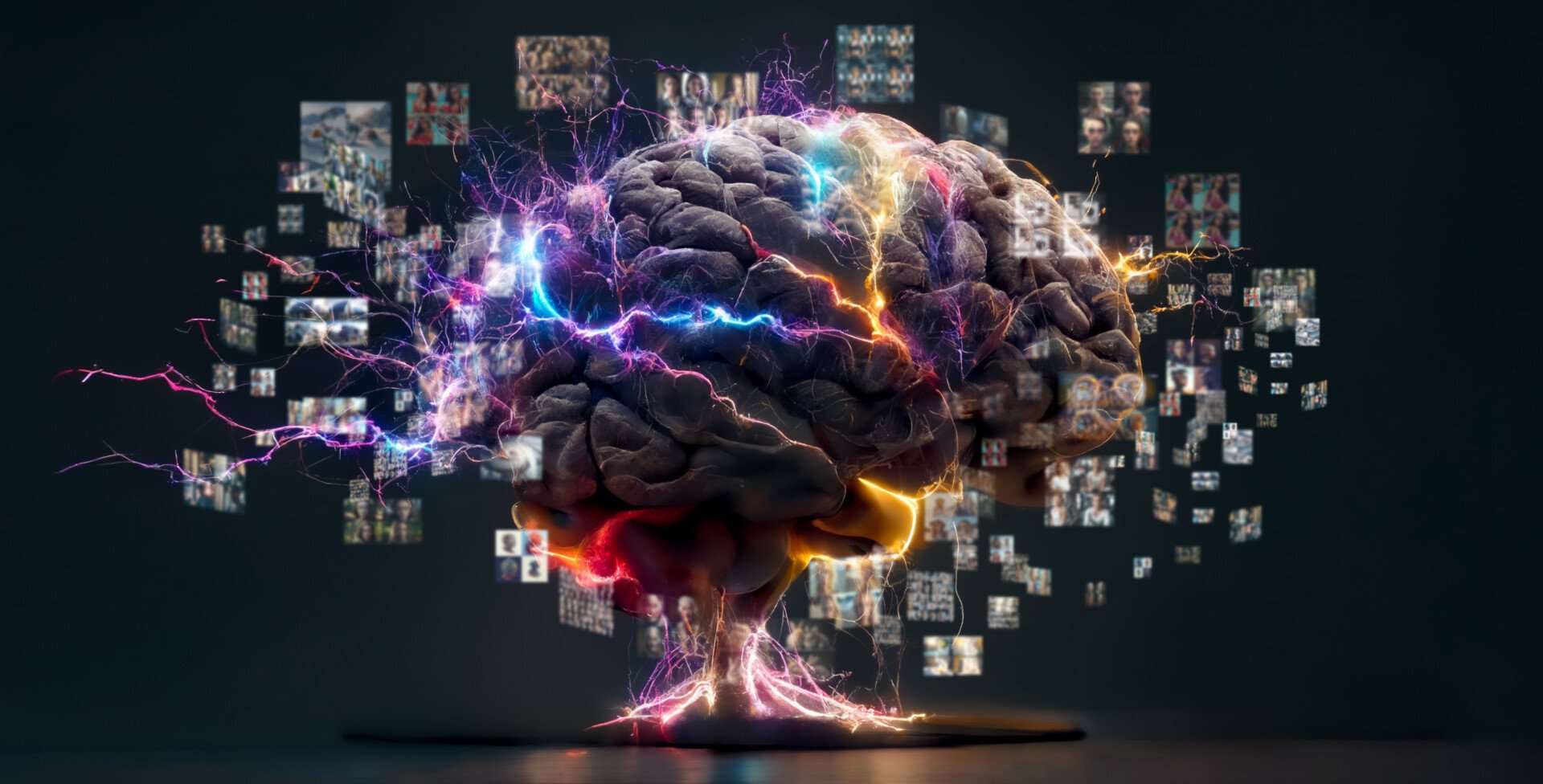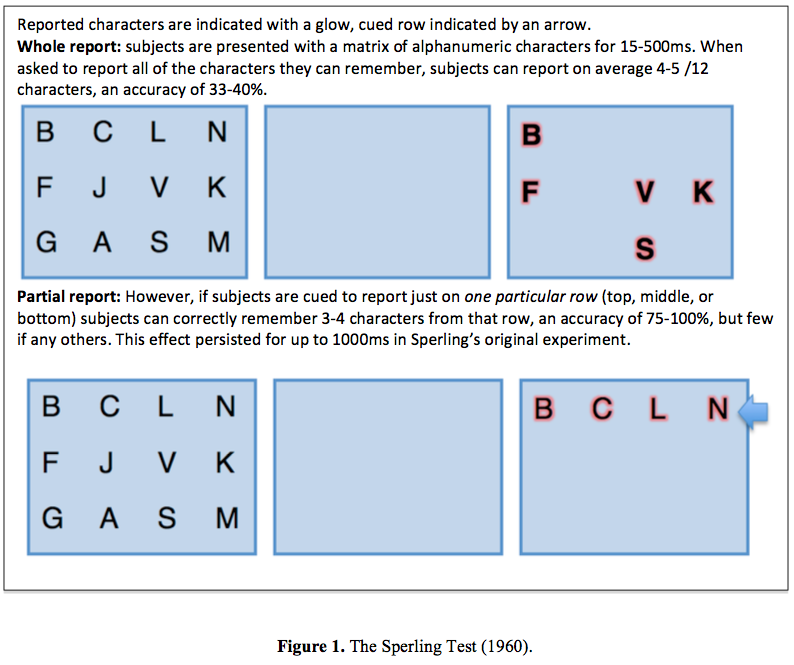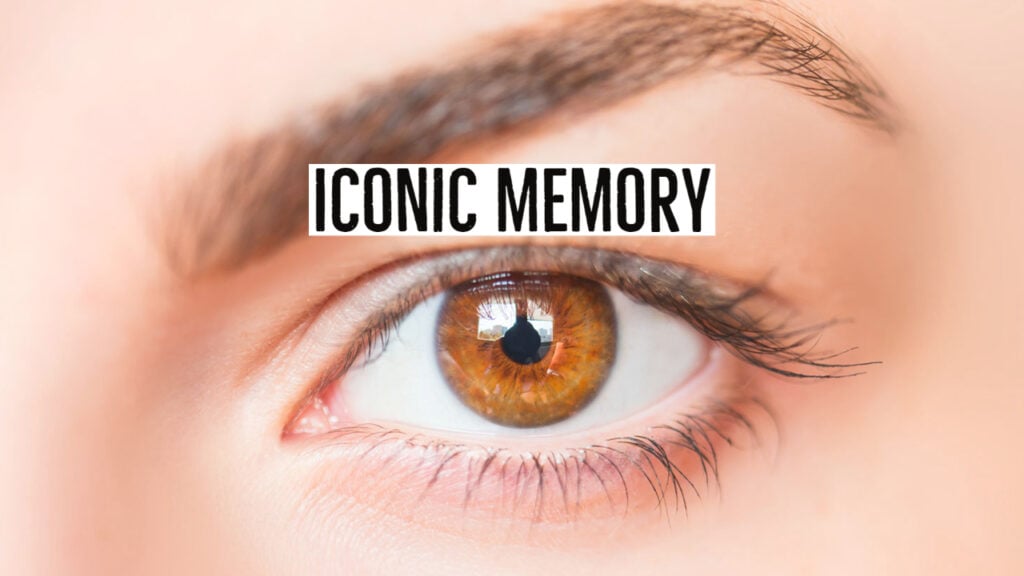On This Page:
Iconic memory is the visual sensory memory register which stores visual images after the extinction of a physical stimulus. While iconic memory contains a huge capacity, it declines rapidly.
Information stored in iconic memory generally disappears within half a second (depending on the brightness).
Iconic memory is a sensory memory component involving a fast-decaying visual information store (Sperling, 1960). It provides a coherent yet fleeting representation of our visual perception (Pratte, 2018).
Aristotle was among the earliest individuals to have documented the persistence of a visual representation of an object following its physical extinction (Allen, 1926). He pointed out that experiencing a dream involves afterimages.
In the 18th and 19th centuries, observing the trail of light engendered by a moving stick’s shining ember elicited the curiosity of many researchers. They delved into the empirical analyses of this phenomenon which was subsequently described as visible persistence (Coltheart, 1980).

Eventually, in 1960, the American cognitive psychologist George Sperling, via several experiments, confirmed capacity and duration as parts of a memory system called visual sensory memory (Sperling, 1960).
Seven years later, Ulric Neisser introduced the term ‘iconic memory’ to refer to this fast-decaying store of memory (Neisser, 1967).
According to the current understanding of iconic memory, informational persistence and visual persistence embody fundamentally distinct properties, and the former is thought to substantially contribute to visual short-term memory (Coltheart, 1980; Irwin & Yeomans, 1986).
Examples of Iconic Memory
Following are some examples of iconic memory:
- You briefly survey the objects in your bedroom before turning the lights off. The memory of how your surroundings appeared is an example of iconic memory.
- You pass a huge billboard while driving on the highway. Your memory of what you saw on the billboard is an example of iconic memory.
- While riding on the train, you see a lamb grazing in the meadows. The memory of what you briefly beheld is an example of iconic memory.
- You are outside on a dark and rainy night. Suddenly, your surroundings are lit up by a flash of lightning. The fleeting image you saw under the brief glow, which you could subsequently recall, is an example of iconic memory.
Sperling’s Experiments
In his initial experiments conducted in 1960, Sperling presented the observers with a tachistoscopic stimulus comprising various alphanumeric characters for nearly 50 milliseconds (Sperling, 1960).
Afterward, based on a cue, the participants had to recall lines of letters from the display. The performance of memory was compared under whole report and partial report conditions.
What was the difference between Sperling’s full report and partial report tasks?
While the “whole report” required the participants to recall elements according to their original spatial positions, the “partial report” demanded that subsets of the display’s characters be identified based on cued recall at different time intervals. A high, medial, or low tone would indicate which group of characters needed to be reported.

Under the whole report conditions, the participants were generally able to recall about 35% of the characters on display (Sperling, 1960). The findings suggest that the whole report is restricted by a system of memory that has a capacity of 4 to 5 objects.
On the other hand, under the partial report conditions, the participants could recall a specific row in 75% of the trials.
Because the participants were unaware of the row that they would have to recall, the performance herein was tantamount to a random sampling of the memory of the participants for the entire display.
The results herein seemed to suggest that three-fourths of the visual display remained accessible to memory. This outcome signified a manifest increase in iconic memory’s hypothesized capacity.
Iconic Memory and Change Blindness
Change blindness is the phenomenon whereby an alteration introduced to the visual stimulus escapes the notice of the observer (Becker, Pashler & Anstis, 2000). The brief interval between the two successive visual scenes, the latter of which is slightly altered, is called the interstimulus interval.
The length of the interstimulus interval is thought to reduce the iconic memory store. In other words, iconic memory is what enables the detection of changes in a visual scene (Persuh, Genzer & Melara, 2018).
However, lapses in iconic memory, which can be defined as change blindness, are likely to occur in proportion to the length of the interstimulus interval.
Neurology Related to Iconic Memory
The retina’s photoreceptors, the retinal ganglion cells, the middle occipital gyrus, proteins in the brain and various genetic factors impact the functioning of iconic memory.
The visual sensory pathway plays a vital role in iconic memory. The retina’s photoreceptors, namely rods, and cones, remain active beyond a stimulus’ physical offset (Irwin & Thomas, 2008). The transient M-type cells and the sustained P-type cells of the retinal ganglion cells are also involved (Levick & Zacks, 1970).
While the former are active solely during stimulus onset and offset, the latter are active even in between. The primary visual cortex within the occipital lobe, too, plays an important role in the process (Nikolić, Häusler, Singer & Maass, 2009).
Moreover, the middle occipital gyrus shapes iconic memory’s capacity to detect change (Beste, Schneider, Epplen & Arning, 2011). Proteins in the brain and various genetic factors also impact iconic memory’s functioning.
Key Takeaways
- Iconic memory is a sensory memory that stores images for a fraction of a second.
- Iconic memory allows for the retention of visual sensory impressions following the cessation of the original stimulus, with the result that a visual stimulus is subjectively sustained by up to several hundred
milliseconds. - In 1960 George Sperling demonstrated that, for a brief period following the termination of a 50-millisecond display of letters, more information was available than an observer could normally report.
- Future studies have focused on the effects of luminance, duration, contrast, and background level on the clarity and duration of iconic memory storage.
FAQs
What does iconic memory store?
Iconic memory stores visual information from the environment, allowing for brief and temporary retention of visual stimuli. It is responsible for holding a visual snapshot of the sensory input before further processing and interpretation occur.
What is the duration of iconic memory?
The duration of iconic memory is very brief, typically lasting for a fraction of a second to a few seconds. It is a fleeting and transient form of memory that provides a short-lived representation of visual information before it quickly decays or is overwritten by new incoming stimuli.
References
Allen, F. (1926). The persistence of vision. American Journal of Physiological Optics, 7, 439–457.
Becker, M. W., Pashler, H., & Anstis, S. M. (2000). The role of iconic memory in change-detection tasks. Perception, 29 (3), 273-286.
Beste, C., Schneider, D., Epplen, J. T., & Arning, L. (2011). The functional BDNF Val66Met polymorphism affects functions of pre-attentive visual sensory memory processes. Neuropharmacology, 60 (2-3), 467-471.
Coltheart, M. (1980). Iconic memory and visible persistence. Perception & psychophysics, 27 (3), 183-228.
Dick, A. O. (1974). Iconic memory and its relation to perceptual processing and other memory mechanisms. Perception & Psychophysics, 16 (3), 575-596.
Irwin, D. E., & Yeomans, J. M. (1986). Sensory registration and informational persistence. Journal of Experimental Psychology: Human Perception and Performance, 12 (3), 343.
Irwin, D. E., & Yeomans, J. M. (1986). Sensory registration and informational persistence. Journal of Experimental Psychology: Human Perception and Performance, 12(3), 343.
Irwin, D., & Thomas, L. (2008). Neural basis of sensory memory. Visual memory, 32-35.
Levick, W. R., & Zacks, J. L. (1970). Responses of cat retinal ganglion cells to brief flashes of light. The Journal of Physiology, 206 (3), 677-700.
Neisser, Ulric (1967). Cognitive Psychology. New York: Appleton-Century-Crofts.
Nikolić, D., Häusler, S., Singer, W., & Maass, W. (2009). Distributed fading memory for stimulus properties in the primary visual cortex. PLoS biology, 7 (12), e1000260.
Persuh, Marjan; Genzer, Boris; Melara, Robert (20 April 2018). Iconic memory requires attention. Frontiers in Human Neuroscience, 6, 126.
Pratte, M. S. (2018). Iconic memories die a sudden death. Psychological science, 29 (6), 877-887.
Sperling, G. (1960). The information available in brief visual presentations. Psychological monographs: General and applied, 74 (11), 1.
Further Reading



